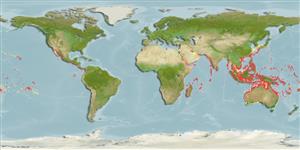Bivalvia |
Ostreida |
Pinnidae
Environment: milieu / climate zone / Mức độ sâu / distribution range
Sinh thái học
; Mức độ sâu 0 - 50 m (Tài liệu tham khảo 75831). Tropical
Indo-Pacific: from East Africa, including Madagascar, the Red Sea and the Persian Gulf, to eastern Polynesia; north to Japan and Hawaii, and south to Queensland and New Caledonia.
Length at first maturity / Bộ gần gũi / Weight / Age
Chín muồi sinh dục: Lm ? range ? - ? cm Max length : 48.0 cm SHL con đực/không giới tính; (Tài liệu tham khảo 348); common length : 30.0 cm SHL con đực/không giới tính; (Tài liệu tham khảo 348)
Shell reaching a very large size, thick and solid, inflated, variable in shape from triangular to hatchet-shaped or subglobular. Dorsal margin usually nearly straight, posterior margin broadly oval to somewhat truncate in outline. Ventral margin broadly convex posteriorly and concave near the umbones, often strongly lobate in medium-sized and large specimens. Outside of valves with 10 to 17 main radial ribs, often bearing scale-like spines, and with weaker interstitial riblets. Internal nacreous layer moderately strong, undivided, occupying the anterior half or 2/3 of valves. Hind margin of posterior adductor scar slightly protruding beyond the nacreous area (protrusion of adductor scar more developed in mature specimens). Colour: outside of shell dark reddish brown to nearly black, usually dull. Shell material semitranslucent, appearing a rich reddish purple when viewed with transmitted light. Interior dark brown to black, iridescent on nacreous area.
Because it attains a large size, this common species is probably one of the most economically important members of the family in the Indo-West Pacific. Beautiful but fragile black pearls are sometimes produced by the animal (Ref. 348). Intertidal to subtidal, on sand and mud (Ref. 75840).
Life cycle and mating behavior
Chín muồi sinh dục | Sự tái sinh sản | Đẻ trứng | Eggs | Sự sinh sản | Larvae
Members of the class Bivalvia are mostly gonochoric, some are protandric hermaphrodites. Life cycle: Embryos develop into free-swimming trocophore larvae, succeeded by the bivalve veliger, resembling a miniature clam.
Poutiers, J.M. 1998 Bivalves. Acephala, Lamellibranchia, Pelecypoda. p. 123-362. In Carpenter, K. E. and V. H. Niem. 1998. FAO species identification guide for fishery purposes. The living marine resources of the Western Central Pacific. Volume 1. Seaweeds, corals, bivalves, and gastropods. Rome, FAO. (Tài liệu tham khảo 348)
IUCN Red List Status
(Tài liệu tham khảo 130435: Version 2025-1)
CITES status (Tài liệu tham khảo 108899)
Not Evaluated
CMS (Tài liệu tham khảo 116361)
Not Evaluated
Threat to humans
Harmless
Human uses
Các nghề cá: Tính thương mại
| FishSource |
Các công cụ
Thêm thông tin
Sinh thái dinh dưỡngFood items (preys)
Thành phần thức ăn
Thành phần thức ăn
Các động vật ăn mồi
Population dynamicsSự sinh trưởngMax. ages / sizesLength-weight rel.Length-length rel.Length-frequenciesMass conversionSự phong phú Life cycleSự tái sinh sảnChín muồi sinh dụcSự sinh sảnĐẻ trứngEggsEgg developmentLarvae PhysiologyThành phần ô-xy
Human RelatedStamps, coins, misc.
Các nguồn internet
Estimates based on models
Preferred temperature
(Ref.
115969): 24.2 - 29.1, mean 28 (based on 1288 cells).
Fishing Vulnerability
Moderate vulnerability (38 of 100).
Price category
Unknown.
